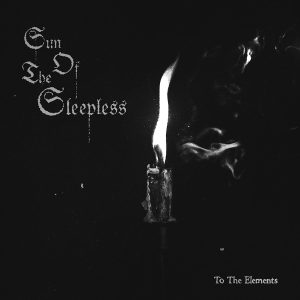
Top Albums of 2017 - Jon Rosenthal

…
The dreaded year-end list. I believe I lectured the lot of you on the whole “don’t be prolific” thing, which I still hold dear (but I won’t make that same point again. Fine.), so it’s lecture time to talk at the lot of you again. As it turns out, only listening to new music gives me the worst anxiety. Sure, there is always good music to hear and it probably deserves a listener or two, but forcing familiarity kind of… sucks. It sucks a lot. Sometimes I feel like I’m on a playdate with the band because our moms met at the grocery store and wanted to try and do that weird “we are moms and we should be friends” thing. It doesn’t feel too natural when compared to the natural way people find or discover new music.
This was the year of nostalgia, really digging into the music which inflamed my passion in the first place. There is something so comforting in revisiting the music you loved as a teenager and finding out it’s still great. There is a lot of wisdom to be gained from these older releases, and sometimes, if we’re lucky, the people who made them can offer valuable insight. Listening to the music I loved when I was a teenager, when I first tried to make music on my own, brings a sense of catharsis and wholeness to me which taking brief, abandoning steps into new music I likely won’t listen to again does not offer. I suppose talking with some of my favorite artists about their older releases helped fuel my own reminiscence, and maybe the resurgence of the “established artist Renaissance” which inexplicably happened this year (great new albums from Satyricon, Fleurety, Paradise Lost, Cannibal Corpse, Samael, Electric Wizard, Sarke, Steven Wilson, and so on), hasn’t helped, but it’s really re-solidified my own taste.
The music which sticks with you does that for a reason. Remembering it so vividly makes it timeless, if just to you. In my own searches, I found many (almost too many) albums which I’ve essentially memorized, back before I had to dissect each new album; a time when I would just sit and let something play on repeat. I’ve tried to reclaim that again this year, but… y’all make too much music. I hate to go back on my promise against lecturing about prolific artists, but… stop abusing Bandcamp: don’t put out five two-song demos over the course of a few months. Let it breathe! Maybe then you can make something timeless.
So, before we really dig into what I liked from this year, here are my top 10 nostalgia listens of 2017:
Kvist – For kunsten maa vi evig vike
Empyrium – Songs of Moors and Misty Fields
Ulver – Nattens Madrigal
Drudkh – their first four albums count as one, right?
Porcupine Tree – In Absentia
Alcest – Souvenirs d’un Autre Monde
Nortt/Xasthur – Hedengang/A Curse for the Lifeless
Katatonia – Discouraged Ones
Dornenreich – Hexenwind
Anathema – Alternative IV
You all need to listen to these albums. They are good for your health .Part of me wonders if this nostalgia clouded how I enjoyed new music this year, but I also don’t really care. This guy knows what he likes. A few reminders:
1) This covers from December 2016 through November 2017. I’d add the new Nortt album if I could, otherwise.
2) That one album you like isn’t missing, it’s just on your list and not mine. Don’t ask where it is, because it isn’t here.
In an attempt to be nice, or at least come off as such, I am mildly curious as to what your favorites are, so be sure to comment with your top three or five. Be sure to add links to save us the trouble of hunting down your favorite raw black metal band with an unpronounceable name, yeah?
See you next year. Be nice.
…
Honorable Mentions:
20. Vintersorg – Till fjälls, del II (Napalm Records, Sweden)
19. Sarke – Viige urh (Indie Recordings, Norway)
18. Nocturnal Triumph – Into Light’s Graven Womb (GoatowaRex, United States)
17. Wode – Serpents of the Countercosmos (Avantgarde Music, England)
16. Samael – Hegemony (Napalm Records, Switzerland)
15. Mork – Eremittens Dal (Peaceville, Norway)
14. ALA.NI – You & I (No Format/Sony Music, France)
13. Aerial Ruin – Nameless Sun (Independent, United States)
12. Kimi Kärki – Eye for an Eye (Svart Records, Finland)
11. Anguis Dei – Ad Portas Serpentium (Svart Records, Japan)
…

Following a decade-long slumber, Markus “Ulf Theador Schwadorf” Stock’s sleepless giant re-emerges from self-imposed exile. More popularly known for his work as the legendary, romantic Empyrium, Stock extended his talents into select, sparse side projects which, too, met their demise with his main project in 2004. Sun of the Sleepless was by far Schwadorf’s most unique child, at least aside from the pastoral Empyrium, eventually growing into a bizarre, chilling juxtaposition of Burzumic asceticism and mechanical trip-hop beats. In a way, the void sounds of Sun of the Sleepless’s self-described “poetic black metal” acted as a foil to Empyrium’s lush, autumnal gloom.
After Empyrium’s reformation in 2010, The Turn of the Tides marked another imbalance in Schwadorf’s performance. It wasn’t bad, by any means, but there was a certain revelry in the band’s performances of songs like “The Franconian Woods in Winter’s Silence” which spoke to a greater desire to record something marginally blackened once more. Sun of the Sleepless’s sudden return certainly fills that void, but this new incarnation shows Schwadorf’s solo project casting off chilling electronic detachedness in favor of the emotive atmospheres of his earlier works, albeit through a more modern, atmospheric black metal prism. The bombastic, spine-tingling aura of To The Elements recalls this solo artist’s early-and-constant perfection of the “gothic metal” genre, projecting a cobwebbed, Victorian misery on a black metal canvas. In Sun of the Sleepless’s resurrection, Schwadorf finds balance once again.
Listen here.
…

The music found on Markerna bortom is smooth and balanced, blending rounded, whispering neofolk with nostalgic albeit lively rock and metal. Much like his previous work in Lönndom, to which Petterson alluded when this album was announced, Markerna bortom is music of duality, celebrating myths and the might of nature from a source of awe and reverence, richness and acidity, focused through this unique musician’s creative lens. Though nostalgic and continuing a style from a time past, the tense, beautiful autumn of Markerna bortom follows Petterson’s ever-maturing style, a constant practice which dates to the 1990s. Saiva’s pastoral beauty will be a lively addition to any playlist for autumns and winters to come.
Listen here.
…
Urarv is strange. There are elements in Aurum which seem familiar on the surface level: the black metal-esque riff-work, the harsh vocals (Aldrahn’s unique howling, ranting, and raving), the rhythmic intensity. It all feels like black metal, but there is this air of avant (or at least progressive) rock which takes the band into a completely separate territory. Aldrahn, Patricia, Sturt, and the surprising addition of Ynleborgaz (Make a Change, Kill Yourself…, Angantyr) take the initial separation of black metal approached by the second wave stalwarts in the late 1990s to early 2000s — what was initially called post-black metal — and twist it into a jagged, uncanny valley version of itself. It resembles black metal on the surface, and yet there is something “off” about it: something unsettling which suddenly becomes glaring and upsetting. Of course, upsetting seems to be the root of Urarv’s inspiration, first conceived by Aldrahn’s meditations on modern ego during a stay in a mental care facility, and Urarv itself seems to separate from black metal’s definition-obsessed ego.
Listen here
…
What a befuddlingly unique, playfully dark album. The band’s self-described “progressive pop” is certainly true to its name, a dark cabaret of stark, urban electronics, complex compositions, and snide charm. Never before have I heard such a stunning representation and complexities of interpersonal relationships through a ten-minute ballad about baseball, and yet I am wholly convinced. Even now, after spending months and months with Blackbox, I find myself mostly unable to put into words why I like it, and yet each listen is completely mesmerizing and revitalizing. I suppose this sort of reaction isn’t really to be expected from someone who is supposed to, you know, write about music, but being presented with something so completely unique presents problems for the writer.
Listen here
…
It seems unfair to include this album on a year-end list. I haven’t been able to listen to it often. It makes me cry. I think it makes a lot of people cry. Phil Elverum has always been one to make music so sincere it borders the uncomfortable, but the plaintive manner in which he mourns his wife’s (Geneviève Castrée, 1981-2016) death through diary entries and explanations to his infant daughter is just heartbreaking. It feels so real, wearing his sadness on his sleeve to somehow make sense of it (in his own words, “it’s dumb”), and his exceedingly lonely musical performance only enhances his wandering ramblings. Little hints at melodies from old songs of heartbreak (the small reference to “The Moon” in “Soria Moria” just ruins me) carry so much more weight now from the broken man trying to hold himself upright for his daughter. I honestly can’t listen to it without full preparation, because my day will be over and I will be inconsolable. How does something so emotionally potent exist? Does something I can’t listen to really deserve to be a favorite of mine? From the bombastic, zen mind explorations of Sauna, we return to Elverum’s fragile state, that which fueled so much of his music. I feel wrong liking this as much as I do.
Listen here
…
What kind of year is it where Satyricon’s new album is a “dark horse”? After their self-titled album’s abandoning of the “black ‘n’ roll” style to which they had grown accustomed between the legendary Rebel Extravaganza and The Age of Nero, the slate was wiped clean for this long-standing, creative duo. Now under a much more progressive guise, Satyricon turns black metal on its head through odd phrasing, deep textures, and lengthy melodies, all of which traverse their discography but with a future-bound momentum. Sigurd “Satyr” Wongraven is generally one to think himself a genius (and quite literally reinforces that in Dayal Patterson’s Black Metal: The Cult Never Dies, Vol. 1), but this is the first time in years where I side with his ego. Maybe this new direction was sparked by his own experience with mortality, or maybe he just got bored of stagnating, but Deep calleth upon Deep‘s own creative spirit reflects the bizarre nature which made Satyricon’s early works so inspired and venerable.
Listen here
…
I revel in gloom. It’s true. I also love Planning for Burial, which is also true. Thom Wasluck is this well of creative despond, and each piece of music he releases is like an arrow straight to my soul. Maybe a little closer to Leaving this time around, Wasluck’s reaffirmation of “Gloom,” some misshapen mass of metal, slowcore, post-rock, and shoegazing ambiance, is all the more bombastic and heart-baring. Below the House is this strange “missing link” between what I thought was a duality in my taste, bridging my love of soft, textured indie rock with the volume and violence of metal. A truly stirring album.
Listen here
…
Following a mildly disappointing career as a rock band (I felt Kristoffer “Garm” Rygg’s voice was too smooth and sultry for what was otherwise great music), Ulver follows my entire musical timeline. From the beloved Trilogie onward, there was this modernizing which felt like, for lack of a better term, “growing up.” Or “out.” Throughout all the adventures through electronic music, trip-hop, ambiance, Garm and Tore’s vision still retained the darkness held at Ulver’s core since even before Tore even joined the band in 1997. Returning back to the electronic music which defined their mid-period (Perdition City, Blood Inside, and Shadows of the Sun), Ulver flexes the pop sensibilities learned from their active, rock-era, and made a glorious gothic, electronic pop album. Sincerely put, each song packs a wallop; from “Rolling Stone”‘s infectious chorus to “1969”‘s dark brooding, it seems that Ulver’s post-Trilogie career was building up to this moment. Wolves evolve, and so do we.
Listen here
…
The bar for creativity in black metal has risen yet again. For someone who particularly enjoys the stranger half of black metal’s lineage, the return of Fleurety has been met with warm emotion and nostalgia. Joined by a man of equal importance to that creative movement, Ved Buens Ende’s Carl-Michael Eide, we find ourselves thrust into a modernist future, where pop, progressive rock, black metal, and jazz are one and the same. Always ones to give metal convention the one-fingered-salute, Zweizz and Alexander N. refocus their songwriting skills and what was originally a kaleidoscopic, wide view becomes a destructive laser. Rhythmic, joyous, childlike, artful, harmonious, disturbing, The White Death runs this cartoonish, delightful gamut which screams “You didn’t listen to us in the 1990s and now you’ve stagnated.” Fleurety will forever be this beacon of silliness which hurls damnations at the horrendously conservative nature of the style they initially denied.
Listen here
…
God, what a beautiful album. Granted, I feel all kinds of beautiful nostalgia when listening to To the Bone. After so many post-Porcupine Tree albums where Steven Wilson flexed his instrumental prowess, which was fine, he finally returned to the glorious “progressive pop” which made me first fall in love with his music. It seems that remastering all these seminal progressive and art-rock albums (Emerson, Lake, and Palmer, XTC, Peter Gabriel, et al.) has reawoken Wilson’s ear for ear-catching, evocative songwriting, and this tour de force reaffirms and expands upon what made Porcupine Tree so great. I’ll be honest when I said I hesitated listening to this, and even dismissed it at first. It wasn’t until a few months later, when the big voice harmonies hit during the opening title track, that I realized just how stupid and dismissing I was. The emotions I feel when listening to this, somewhere between emotional fragility and intense happiness, left a lasting impression which I relive with each new listen. I listen to To The Bone almost daily, and count the days until I get to (finally) see him perform in May.
Listen here
…











